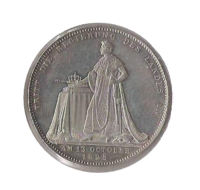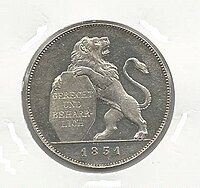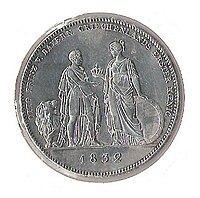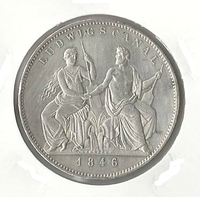History thaler
Geschichtstaler is a name for a series of thalers that Ludwig I of Bavaria (1825–1848) had on regional historical events.
The history thalers minted in the convention base were minted almost every year with a different motif during the reign of Ludwig I. King Maximilian II had the history thaler continue to be minted to a small extent. Not counting among the history thalers, but still coined for a historical event (and as legitimation), the constitution thaler of 1818 under King Maximilian I Joseph (1806–1825) and the peace thaler of Ludwig II for the victory over France.
history
Franz Ignaz von Streber , the curator of the Royal Bavarian Coin Cabinet , wrote a memorandum in 1828: a proposal to transform the larger types of current courant coins (e.g. ducats, thalers and half) into historical commemorative coins. This writing was “very positively received” by the king , and the “history thalers” that arose on the basis of Streber's suggestion are not only an expression of the historicism of that era, but also became a model for the commemorative coinage of other countries, e. B. Saxony, Baden u. a., not only at that time, but to this day.
One has to understand the “historical thalers” and the often sought-after reasons for their expression from the whole intellectual situation of Munich in the 1830s, a time when, starting from the king, a strange will to the monumental seized the whole of life. Ludwig I made Munich the cultural center of southern Germany; an almost naively monumental will to express itself was evident in the history thalers and later in the commemorative double thalers. This may also be the reason why these series have always enjoyed great popularity. The files on the history thalers are incomplete. In 1837 the king asked for a “report on the previous monetary use of historical thalers and the possibilities of increased monetary use in the future”; Above all, an opinion is requested on "whether the previous inhibitions for the development of historical thalers have now been removed".
It is pointed out in various reports to the king that the history thalers marked in the convention base bring the state treasury a not inconsiderable loss, namely about 7 kreuzers each. It was suggested that these popular coins, like the ducats, should be given a premium, and it was noted that in order to prevent the historical thalers from melting down for profit, which can be observed over and over again, they have so far only been "loaned" to private individuals in individual pieces.
However, no table from the Munich mint provides clarity about the actual coinage of the historical thalers, because from 1837 and until 1856 “Convention thalers” are listed in the mint cards. These coins, carried out contrary to the provisions of the Coin Treaty of 1837, can only concern history thalers. The total shown amounts to approx. 170,000 pieces, which are distributed over 24 types, so this would result in around 7,000 pieces for each type if distributed evenly. - In any case, it is certain that the so popular Bavarian history thalers and later also the commemorative double thalers were produced in very small quantities for our current terms and certainly in no case in a minted number over 10,000 pieces. The Konventionstaler Max Josephs and the Krontaler Ludwig I. are, despite the much higher number of mints, considerably rarer than the average historical thaler, because these "common thalers" were not collected.
For the expression of the thaler
Bavaria has minted according to the Convention base since 1753. The weight of fine silver (234 g) became:
- 10 convention thalers struck
- 1 convention thaler = 10 guilders
- 1 guilder = 60 cruisers
- 1 Kreuzer = 4 Pfennig (2Pfennig = 1/2 Kreuzer)
- 1 pfennig = 2 hellers
This 20 Guldenfuß soon developed into 24 Guldenfuß and from 1800 to 24 1/2 Guldenfuß, which became legal in Bavaria in 1837. The connection between the south German 24 1/2 gulden foot and the north German 14 thaler foot represented the club coin minted since 1838, the 2 thaler or 3 1/2 gulden piece.
This explains the weight discrepancies among the history thalers:
- The thalers from 1825–1837 ( St. Michaels Order ) were conventional thalers with a rough weight of approx. 28.06 grams and a fine weight of approx. 23.38 grams of silver, which corresponds to a fineness of 833.3 / 1000. (24 convention thalers)
- The thalers of the years 1837 (from the Mint Association of Southern German States) to 1856 (Maximilians Monument) were double thalers with a rough weight of approx. 37.12 grams and a fine weight of approx. 33.41 grams of silver, which corresponds to a fineness of 900/1000 . (13 double thalers)
- The Siegestaler from 1871 and the Hochzeitstaler from 1867 are club thalers with a weight of approx. 18.52 grams and a fine weight of approx. 16.67 grams of silver, which corresponds to a fineness of 900/1000.
Double thaler from Maximilian II (1848–1864)
History thaler (rather commemorative thaler) of Ludwig II. (1864-1886)
Regarding the planned wedding thalers for the marriage of Ludwig II and Sophie Duchess in Bavaria on October 12th, 1867, which however never came about, the medalist Voigt from Rome wrote on July 29th, 1867 to the mint director at the time: “I want to do what in mine It is hard for you to get the stamps with the two portraits so early that you can get them before October 12th. because such occasional coins lose their value if they don't appear at the right time ... It's a shame that the princess wears her hair so curiously, in the coin you won't know what kind of tiara it is [...] the reverse definitely make reams to be ready at the right time ... "
On December 6, 1906, the court secretariat requested a discount for Prince Regent Luitpold; it is likely to be the only known specimen that later appeared in Schulman's 1926 auction No. 918. On it to read: Ludwig II Koenig v. Bavaria u. Sophie Duchess in Bavaria Verm. d. 12 Octb. 1867 - both heads looking to the right, Voigt below .
The series of commemorative double thalers
The series of commemorative double thalers was continued by the following medals, the size and weight of the double thalers:
- For the opening of the Luitpold Bridge 1890–1891;
- Silver wedding of the later King Ludwig III. 1893;
- Army memorial in the Feldherrnhalle in 1892;
- The new justice building in Munich 1897;
- Army Museum in Munich, 1904.
The coins minted in 1872 and 1873 only concern Siegestaler .
List of Bavarian history thalers
Text sections in bold are the exact reproduction of the font as shown on the original coins. Text sections not in bold only describe the images on the coin.
The thalers are listed according to the years on the coins, not the year in which the thaler actually appeared.
Only the history thalers of Ludwig I (1825–1848) are listed here.
| year | Issue occasion | image |
|---|---|---|
| 1825 | Enter the government of the country - the king standing in coronation regalia . In the section below: " On 13 October 1825 " (backside Ludwig I King of Bavaria, backside remains the same until the 1848 Constitutional Thaler) |

|
| 1826 | His crowns for merit - Below 1826 Reichenbach + Fraunhofer - Both heads facing each other |

|
| 1826 | Relocation of the Ludwig Maximilians Hochschule from Landshut to Munich 1826 - In a laurel wreath on which the Landshut or Munich coat of arms rests on both sides |

|
| 1827 | Bayrisch-Würtembergischer Zollverein - Mercury rod between two horns of plenty. Closed at the bottom in 1827 |

|
| 1827 | Foundation of the Order of Ludwig Order cross between laurel and oak branches. Bottom 1827 |

|
| 1827 | " The Queen of Bavaria donates the Theresa Order " - Order cross between two branches of lily. Bottom 1827 |

|
| 1828 | Blessing of Heaven - medallion with the heads of the queen and the legend Therese Koenigin von Bayern surrounded by eight medallions with the images of the royal children and their names - Maximilian PVB; Otto PVB; Luitpold PVB; Adalbert PVB; Mathilde PVB; Adelgunde PVB; Hildegard PVB; Alexander PVB 1828 |

|
| 1828 | Constitutional column erected by Gr. v. Schoenborn - The column in Gaibach , Lower Franconia . In the section: Inaugurated in 1828 |

|
| 1829 | Trade agreement between Bavaria, Prussia, Würtemberg and Hesse - surrounded by the coats of arms of these four states, two horns of plenty and a staff of Mercury. Down 1829 |

|
| 1830 | Bayerns Treue - Seated Woman ( Bavaria ) with a dog at feet. In section 1830 |

|
| 1831 | An erect lion with a shield that bears the inscription: Righteous and Persistent - in the 1831 section |

|
| 1832 | Otto Prince v. Bavaria Greece's first king - standing woman (Hellas) with Greek coat of arms by her side, hands over a crown to the standing prince. In section 1832 |

|
| 1833 | Zollverein with Prussia, Saxony, Hesse a. Thuringia - Standing woman with Mercury staff and cornucopia, anchor below and front part of the ship. In section 1833 |

|
| 1833 | " Monument of thirty thousand Bayern which in Russian wars death found " - Obelisk in Munich. In section 1833 |

|
| 1834 | Honor is due - In EichenKranz Landtag 1834 |

|
| 1834 | " Memorial of the attachment of Bavaria to its ruling tribe Erected in Oberwittelsbach " - Monument in Oberwittelsbach . Bottom 1834 |

|
| 1835 | " Entry from Baden to the Teutsche Zollverein " - Mercury staff between two laurel branches. Bottom 1835 |

|
| 1835 | Establishment of the Bayrische Hypothekenbank - woman leaning against a column shaft. In section 1835 |

|
| 1835 | " Think. the separation of the Koen. Therese from her son the Koen. Otto erects a monument by Bavarian women at Aibling near Bad Aibling. Bottom 1835 |

|
| 1835 | " First railroad in Germany with a steam car from Nuremberg to Fürth " - Resting woman with a Mercury staff and laurel wreath in her right hand, with her left hand leaning on a winged wheel. In the section: Built in 1835 |

|
| 1835 | Monument of King Maximilian Joseph erected by the capital Munich - Monument in Munich. In section: 1835 |

|
| 1835 | Hand over a teaching institution to the Benedictines again - standing woman (Bavaria) leads two boys to a Benedictine. In section: 1835 |

|
| 1836 | “ Bavaria establishes the h. Ottokapelle zu Kieferfelden in memory of Koen. Otto's farewell v. his fatherland ”- Ottokapelle in Kiefersfelden . In section: 1836 |

|
| 1837 | The Order of St. Michaels to the Order of Merit Determined - Order cross in a laurel and oak wreath. Bottom: 1837 |

|
| 1837 | Mint Association of South German States - Standing Woman (Moneta) between the six coats of arms of Bavaria, Württemberg, Baden, Hesse, Nassau and Frankfurt (in jumping order). In section: 1837 (The suggestion for the issuance of this thaler was made by the king himself) |

|
| 1838 | " The division d. Kingdom on histori. Basis traced back 1838 “- The names of the districts in eight laurel wreaths: Upper Bavaria; Lower Bavaria; Palatinate; O. Pfalz u. Reg .; Ober Frank; Mitt. Frank; Unt. Fr. u. Ash; Schwab. u. Arranged clockwise |

|
| 1839 | Equestrian column Maximilian's I Elector v. Bavaria - equestrian statue. In the section: Established v. King Ludwig I 1839 |

|
| 1840 | Statue of A. Dürer erected in Nuremberg in 1840 - Dürer standing |

|
| 1841 | Statue of Jean Paul Friedrich Richter erected in Bayreuth 1841 Jean Paul standing |

|
| 1842 | Walhalla - Walhalla . In section: 1842 |

|
| 1842 | Maximilian Kronpr. v. Bavaria u. Marie K. Prince. v. Preuss. Verm. D. 12 Octb. 1842 (with variant: October 1st) Both heads looking to the right |

|
| 1843 | Centennial establishment of the University of Erlangen by d. Margr. Friedr. v. Brandenb. Bayr. 1843 - statue of the margrave in Erlangen |

|
| 1844 | Feldherrnhalle - Feldherrnhalle in Munich . In section 1844 |

|
| 1845 | Statue of Canzlers v Fryherrn. Kreittmayr built in Munich in 1845 |

|
| 1845 | Ludwig Hereditary Prince v. B. Born August 25th-Ludwig Koen. Prince v. B. Born 7 January - woman (Bavaria) standing in front of an oak, in each hand a shield with L., above her the crowned second Bavarian coat of arms. In section: 1845 |

|
| 1846 | Ludwigskanal - (Main-Danube Canal) - Seated female and male river deities shaking hands. In section: 1846 |

|
| 1847 | Statue for Prince-Bishop Julius Echter v. Mespelbrunn built in Würzburg in 1847 - standing bishop |

|
| 1848 | Ludwig I gives the crown to his son Maximilian - The king hands over the crown to his son standing in front of him. In section: On March 20, 1848 |
Individual evidence
- ^ Jaeger coin catalog: The more recent coinage of the German states before the introduction of the imperial currency - 5th issue - Kingdom of Bavaria 1806–1871.
- ^ A b Large German coin catalog from 1800 to today.

